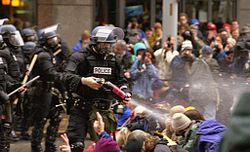1789–1865: Early republic and Civil War

1797–1801: John Adams' presidency
1798: Sedition Act prosecutions against anti-Federalist press
1798 Sedition Act background
1798 Sedition Act attacks on journalists
The Sedition Act was enforced primarily against editors and publishers aligned with the Democratic-Republicans who criticized the Federalist administration of President John Adams. Notable cases included Representative Matthew Lyon (convicted and re-elected while jailed), pamphleteer James Thomson Callender of the Richmond Examiner (fined and imprisoned), and Benjamin Franklin Bache, editor of the Philadelphia Aurora (arrested; died of yellow fever before trial). Federalist judges such as Samuel Chase enforced the law vigorously; contemporaries and many historians have viewed the prosecutions as a partisan effort to suppress opposition newspapers and chill political speech. [4] [5] [6] [7] [8]
Scholars identify roughly 17 indictments and 10 convictions under the Act, almost all involving Democratic-Republican printers or speakers. The statute was drafted to sunset on March 3, 1801; after taking office, President Thomas Jefferson issued pardons and remitted fines. The episode is widely remembered as an early and significant violation of freedom of the press. [9] [10]
1829–1836: Andrew Jackson's presidency
1835: Georgia Guard seizes the Cherokee Phoenix press
In 1835, during the period leading up to the Trail of Tears, the Georgia Guard — a state militia unit organized to police Cherokee territory claimed by Georgia – seized the printing press of the Cherokee Phoenix , the first newspaper published by Native Americans in the United States. [11] [12] The newspaper had been established in 1828 at New Echota, the capital of the Cherokee Nation, and was published in both English and the Cherokee syllabary. [13]
The seizure occurred amid escalating tensions between Georgia and the Cherokee Nation over sovereignty and removal in the wake of the Indian Removal Act. Contemporary and scholarly accounts note that the Guard confiscated the press to prevent anti-removal views from being published, effectively halting the paper's revival efforts in 1835; the paper had already ceased in May 1834 when a federal annuity payment failed. [14] [15] The controversy over removal culminated the same year in the signing of the Treaty of New Echota (December 29, 1835), which became the federal basis for removal despite broad Cherokee opposition. [16] [17]
Exhibitions and scholarship have characterized the 1835 confiscation as an instance of state-sponsored censorship of an Indigenous-run press. [18] The Cherokee Phoenix would not resume as a Cherokee Nation publication until its 20th-century revival; the separate Cherokee Advocate began publication in 1844 in Tahlequah. [19]
1853–1856: Franklin Pierce's presidency
1856: Sacking of Lawrence sheriff seizes the press
The sacking of Lawrence occurred on May 21, 1856, when pro-slavery settlers, led by Douglas County Sheriff Samuel J. Jones, attacked and ransacked Lawrence, Kansas, a town that had been founded by anti-slavery settlers from Massachusetts who were hoping to make Kansas a free state. The incident fueled the irregular conflict in Kansas Territory that later became known as Bleeding Kansas.
The human cost of the attack was low: only one person—a member of the pro-slavery gang—was killed, and his death was accidental. However, Jones and his men halted production of the Free-State newspapers the Kansas Free State and the Herald of Freedom, destroying the presses and offices (with the former ceasing publication altogether and the latter taking months to once again start up). The pro-slavery gunmen also destroyed the Free State Hotel and Charles L. Robinson's house.1861–1865: Abraham Lincoln's presidency
1861: Union military arrests press
In the early months of the American Civil War, Union military authorities arrested a number of newspaper editors and publishers for perceived disloyalty or interference with the war effort, and in many cases shut down their presses. [20]
One widely noted case occurred in September 1861, when Frank Key Howard, editor of Baltimore's Daily Exchange, was arrested by Union authorities and confined as a political prisoner. [21] [22] Howard's paper had published strongly anti-administration editorials and was implicated by federal officials in efforts to stir secessionist sentiment in Maryland; he was first imprisoned at Fort McHenry and later transferred to other military prisons. [23] [24]
Federal forces likewise acted against newspapers in several border states. In St. Louis, on July 12, 1861, Colonel Chester Harding – acting under orders from Brigadier General Nathaniel Lyon — suppressed the Daily Missouri State Journal and arrested its editor, Joseph W. Tucker, on a treason charge. [25] In Baltimore, multiple papers—including the South and the Daily Exchange—were suspended or forced to cease publication following the arrest of their editors. [26]
Contemporary observers and later scholars have described these actions as wartime press suppressions justified by Union officials on grounds of military necessity and national security. [27] [28]
1864: Federal seizure of the New York World and Journal of Commerce
On May 18, 1864, after the New York World and Journal of Commerce printed a forged presidential proclamation, President Abraham Lincoln ordered Major General John Adams Dix to arrest the editors, proprietors, and publishers of the two papers and "take possession by military force" of their printing establishments in New York City, halting further publication until further orders. [29] The spurious proclamation—circulated in the guise of an Associated Press dispatch—named a national day of fasting and prayer and called for an additional draft of 400,000 men. [30] [31]
Dix promptly executed the order: troops occupied the newspaper offices and suspended publication. [32] Within two days, after authorities determined the document was a hoax, the administration rescinded the arrests and allowed the papers to resume; publication restarted by May 23, 1864. [33] [34] Investigators soon arrested the forgers—journalists Joe Howard Jr. and Francis A. Mallison; Howard was imprisoned at Fort Lafayette until August 23, 1864. [35] [36]
The episode provoked sharp debate over wartime press powers. Critics – including Democratic editors and some Republicans – condemned the seizures and arrests as censorship and an overreach beyond civil authority, while administration officials defended them as a temporary military necessity to counter a destabilizing fraud. [37] [38]















